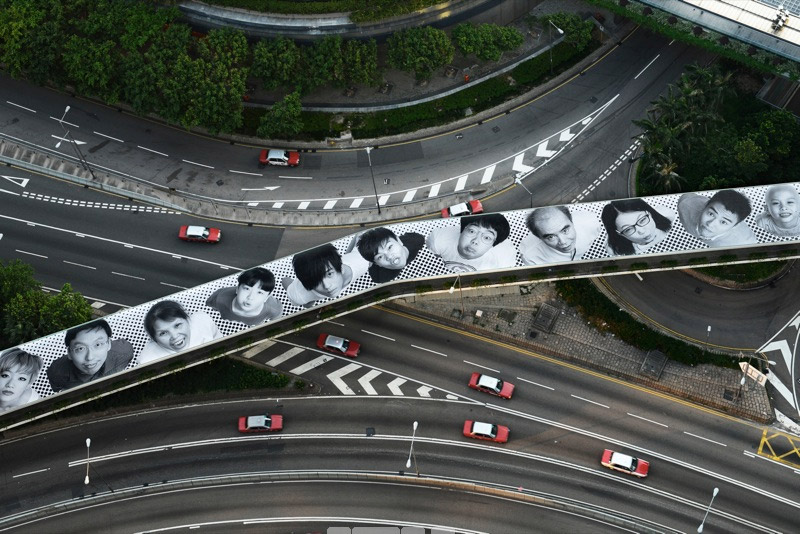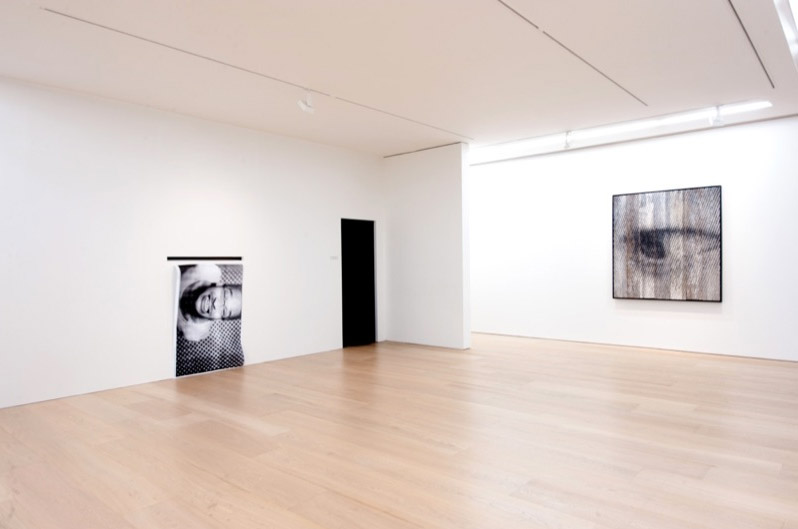Shows
JR’s “Pattern”


Hong Kong is a vertical city. Over 1,000 skyscrapers compete to occupy slender, high-priced columns of air. Its people live and work, on average, 15 floors above ground. Seen from such heights, the urban infrastructure is outlined below as pure geometric forms: lattices of hand-bound bamboo scaffolding clinging to unfinished buildings, red rectangular taxi hoods halted in traffic, square air conditioner units inhaling and exhaling the city’s grit.
This is the view afforded by the light-flooded windows of Galerie Perrotin’s 17th floor space in Central, Hong Kong’s financial district. Recently though, 16 huge black-and-white photographs of upward turned faces—each measuring 6 by 6 meters—span the elevated footbridge above Connaught Road. The artwork can also be seen from nearby public spaces such as the Hong Kong Central Library and the IFC Mall.
The individuals photographed are isolated and enlarged as if under a magnifying glass. A schoolgirl puckers her mouth. A gentleman with a sizable bald patch raises his eyebrows. A single eye and studded ear peek out from long and carefully arranged bangs. These portraits of Hong Kong city dwellers lend human expression to the austere urban grid.
The exhibition “Pattern” is created by a French street artist known only by his initials: JR. The semi-anonymous photographer has pasted photographs of women—victims of violence and injustice—on crumbling favela walls in Brazil and plastered portraits of the dispossessed on shanty roofs in Kenya. In Israel, he posted images of Jews and Arabs on blocks dividing the Israeli/Palestinian territories. His subjects perform for the camera. For instance, in one image, a Jewish man wearing sidelocks crosses his eyes and engorges his cheeks; in another, a swarthy Arab with a grizzled beard and gap-toothed smile exposes the whites of his eyes. JR works so closely to his subjects’ faces that you can sometimes see the 28mm camera lens reflected in their pupils.
The Hong Kong portraits, however, are not of disenfranchised people and are not shot by JR. As part of his new global art project Inside Out (2011– ), some 175 Hongkongers took self-portraits and uploaded the images to the web. Sixteen photos were afterwards selected to be spotlighted on the bridge. These portraits are goofy, and represent a conspicuous and promising effort to raise childish play above the dull and joyless commercial logic of the financial center.

Unfortunately though, because JR’s portraits are contiguous with the city’s billboards and building-sized ads, they are not altogether startling to encounter. While JR laments commercial advertisement’s confiscation of public space, he continues to borrow from its visual vocabulary. Place a logo below the Inside Out images, and you have a handsome ad.
And the footbridge art is an advertisement, to an extent. JR’s work is being sold in Galerie Perrotin: four sculptures executed in cast aluminum—that appear like crumbled billboard poster scraps—and five paintings on flat-paneled, distressed wood. Both mediums depict eyeballs rendered with Roy-Lichtenstein-styled Ben-Day dots.
In addition to these pieces, the gallery hosts a photo booth, a black room cordoned off with a velvet curtain. Inside, a camera hangs down like a light bulb. Visitors enter, tilt their face upwards, press a touch screen and . . . one, two, three, snap! A poster-sized photograph smoothly exits from a slit in the wall outside the booth. The photo booth is one of several that have been installed, as part of the Inside Out project, in public spaces and art institutions around the world, including the Centre Pompidou in Paris and Abu Dhabi’s Manarat al Saadiyat cultural center.
In the context of Hong Kong, the collaborative aspect of JR’s earlier works is noticeably absent. When ArtAsiaPacific visited Perrotin, a primly dressed woman popping in and out of the photo booth took half a dozen self-portraits, fixing her hair and applying lipstick between takes. A young couple printed out their pictures and exchanged them with one another. Although these are gifts that visitors are encouraged to paste in their own community, we might wonder how many portraits will end up on the streets, giving self-expression a locus in public space.
Watching people examine their posters in the elevator, it is unclear if JR’s new project issues a big enough challenge to this commercial city—to the desire to vainly stare at ourselves.







